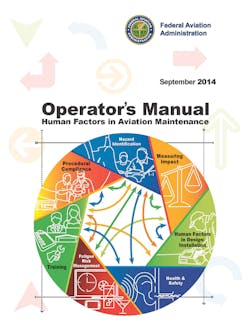Callout: The challenges are complex and ingrained in aviation maintenance. The challenges are part of the culture and “culture” takes a long time to build and a long time to change.
The author revisits the top maintenance human factors challenges comparing a 2010 ranking with one in 2014. U.S. and international aviation maintenance human factors specialists indicate that the major issues have not changed substantially. The No. 1 challenge, not mentioned in past studies, was a combination of two factors that combined to say that industry leadership is not demonstrating sufficient attention to the corporate safety culture.
The 2010 international rankings
In 2010, the FAA assembled a panel of maintenance human factors (Mx HF) to identify and rank the top human factors challenges. Participants included representatives from airlines, MROs, manufacturers, and government. The European Human Factors Advisory Group did the same drill in Europe. There was a 60 percent overlap in the top five challenges as shown in Table 1. The matching challenges were worker fatigue, safety culture, and measuring impact of maintenance HF programs. This ranking reinforces the fact that humans are humans and have the same challenges no matter where they are working. One significant difference is that Europeans have the challenge of 28 national regulatory authorities and many others, including the United States, with whom they have bilateral agreements (meaning that local Aviation Safety Inspectors enforce the EASA regulations).
Table 1: Top 5 EU-U.S. Maintenance Human Factors Challenges in 2010
North America-US Europe
Using technical publications Measuring impact of Mx HF programs
Worker fatigue Expanding Mx HF across all European countries
Safety culture Worker fatigue
Voluntary reporting Safety culture
Measuring impact of HF programs Standardizing regulatory oversight
The 2014 international rankings
A single web-based questionnaire provided the data in 2014. It was sent to a selected sample of the maintenance industry, most of whom were involved in the 2010 ranking activity. Twenty-five percent were from Europe, the rest from the United States. Seventy-five percent of the Europeans and 60 percent of the U.S. sample responded within the allotted time frame. The end result was that 75 percent of the responses were from the States. The U.S. has a larger aviation industry so this representation is acceptable. The questionnaire was open-ended. The respondents did not pick from a list but merely wrote their own short description of the challenges.
Sixty-three percent (51 responses) maintenance human factors returned answers. That is a very respectable response rate to an open-ended survey with a short response window. Some respondents later told us that they queried their work force and managers before responding. We are certain that this sample size and number of responses yielded valid and reliable information.
The top five challenges represented 67 percent of the combined EU and U.S. responses. Table 2 shows the list of the top challenges that combines all respondents. The combination of culture/leadership, using technical publications, and worker fatigue represented 50 percent and 54 percent of the votes in EU and U.S., respectively. The Europeans included “oversight and regulations” in their top five. In the United States there was a four-way tie for fourth place to include “HF training,” “pressure/stress,” “measuring impact,” and “voluntary reporting.” In other words, there was general agreement between EU and U.S.
Table 2: Top 5 Maintenance Human Factors Challenges in 2014
Culture/leadership
Using technical publications
Worker fatigue
Voluntary reporting
Measuring impact of HF programs (tied with “HF training”)
The open-ended responses were high value. The author and Ms. Joy Banks, a psychology technician from the FAA Civil Aerospace Medical Institute, deliberated on the interpretation and categorization of the responses. The work was tedious but interesting. Table 3 shows examples of the information rich free-form challenge statements that were coded in to one of 21 categories.
Table 3: Example Challenges from Respondent’s Comments
• Leadership managing to outcomes rather than process - work forces tend to receive this message as "our procedures aren't important enough to adhere to." Safety culture: Maintenance issues that cause accidents or perpetuate poor maintenance begin with management making a conscious decision to lower the bar ...
• Application of just policy to lead a just culture for improved reporting
• Failure to follow procedures/processes policies
• Fatigue/alertness: Company needs to develop and enforce a max duty time for AMTs
• Complacency: Doing things on a routine basis and bi-passing the maintenance manual. e.g. tire change
• Integration of human factors principles into day-to-day operations
Comparing the two surveys
The results between 2010 and 2014 are consistent, with a 75 to 80 percent overlap in identified challenges. Since it was extremely difficult to separate comments about culture vs. comments about leadership those categories were combined. The result was that “culture/leadership” moved to the top of the list. The EU continues its struggle with consistent member states so that challenge remains in the EU top five. The United States identifies “HF training” and “pressure/stress,” which are not in Europe’s top five. The fact that there are more similarities than differences is significant. It means that EU and U.S. can share approaches to address the challenges.
There similarities from 2010 to 2014 should not be too alarming. The challenges are complex and ingrained in aviation maintenance. The challenges are part of the culture and “culture” takes a long time to build and a long time to change. The good news is that FAA and EASA have been actively addressing the challenges with applied research programs and proposed or enacted regulatory changes. Enactment and additional proposed SMS regulations in the EU are a step in the right direction. While SMS was not addressed in the top five it is certainly an important corrective action to address many of the challenges. FAA SMS regulations, especially for airlines, are proceeding toward adoption. FAA Administrator Huerta has placed highest strategic priority on “risk-based decision making.” This process uses data-driven tools to make smarter, risk-based decisions about safety. Since human performance and human factors are among the highest risks in aviation one might expect increased attention to this high risk area.
Products and regulations to address the MxHF challenges
FAA and EASA have been addressing the top five challenges, even before the 2010 list was identified. Many of those efforts have been described in issues of AMT Magazine, Ground Support Worldwide, and other Cygnus publications. EASA has created regulations for human factors training, over 10 years ago. New EASA proposals (See EASA NPA 2013-1 and 2013-19) are suggesting new content for HF training, stricter HF knowledge requirements for HF trainers and ASI inspectors, and requirements for a fatigue risk management system for maintenance organizations.
FAA’s robust MXHF program has created a variety of solutions for topics like Fatigue Risk Management, Measuring Impact of HF programs, HF training, and more. That information is available on the convenient web site address www.humanfactorsinfo.com. Table 4 shows a partial listing of products that are on the web site.
Table 4. Sample information on FAA MxHF web site (www.humanfactorsinfo.com)
· Maintenance Fatigue Web-based Training System
· Fatigue Video titled “Grounded”
· Calculate Return on Investment – Procedures and Software
· Workshop reports on: Fatigue: Using Technical Documentation; Collecting and Using Voluntary Data
· Line Operations Safety Assessment for Maintenance – Procedures and Software
· The Operator’s Manual for Human Factors in Maintenance
· The Maintenance Human Factors Training Program – 150 PowerPoint Slides with 11 Videos
What you should do
Responding to the survey and reading this article is helpful but is a mere start or continuation of your quest to tackle the challenges. The top five challenges are not new and many of the solutions are available. Your job, in industry, is to convince your managers to commit to enacting the solutions and to dedicate the necessary resources.
You must be proactive when you see something that is a likely hazard that contributes to overall safety risk. Your job, as a manager, is to take a leadership role in addressing these known challenges that are contributing to risk. You must encourage all workers to voluntarily report potential hazards. Tell everyone about such reports. Strive to alter the reporting culture.
Your job, as a regulatory inspector is to ask your airlines and repair stations what they are doing to address the top five MxHF challenges in their organization. You may not be enforcing a specific regulation but you will be fostering a positive safety culture. In the meantime FAA, EASA, and other regulators must evolve and support the products that they created with their industry partners. Expect to see me, Bill Johnson, doing that!
Dr. Bill Johnson is the FAA Chief Scientific and Technical Advisor for Human Factors in Aircraft Maintenance Systems. Johnson is a member of the Human Factors Advisory Group to the European Aviation Safety Agency (EASA). Johnson is a pilot and an A&P for close to 50 years.
About the Author

Dr. Bill Johnson
Chief Scientific and Technical Advisor Human Factors in Aviation Maintenance, FAA
““Dr. Bill” Johnson is a familiar name and face to many industry and government aviation audiences. Johnson has been an aviator for over 50 years. He is a pilot, mechanic, scientist/engineer, college professor, and senior executive during his career. That includes 16+ years as the FAA Chief Scientific and Technical Advisor for Human Factors.
Dr. Bill has delivered more than 400 Human Factors speeches and classes in over 50 countries. He has 500 + publications, videos, and other media that serve as the basis for human factors training throughout the world.
Recent significant awards include: The FAA “Charles E. Taylor Master Mechanic” (2020); The Flight Safety Foundation - Airbus “Human Factors in Aviation Safety Award” (2018), and the International Federation of Airworthiness “Sir Francis Whittle Award” (2017).
Starting in 2021 Johnson formed Drbillj.com LLC. In this new venture he continues to bring decades of human factors experience to aviators, worldwide.
